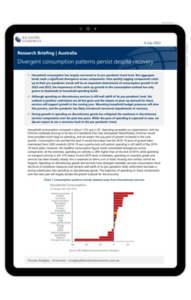Divergent consumption patterns persist despite recovery

Household consumption increased a robust 1.5% q/q in Q1. Spending exceeded our expectations, with the Omicron outbreak proving to be less of a headwind than was anticipated. Nevertheless, Omicron would have provided some drag on spending, and we expect the q/q pace of growth increased in the June quarter. Consumption has reached the level it would have been had the 2018-19 pace of growth been maintained from 2020 onwards (2018-19 was a particularly soft period; spending is still adrift of the 2010- 19 trend path). However, the headline consumption figure masks remarkable divergences across components.
What you will learn:
-
Household consumption has largely recovered to its pre-pandemic trend level. But aggregate levels mask a significant divergence across components. How quickly lagging components catchup to their pre pandemic trends will be an important determinant of consumption growth in H2 2022 and 2023; the importance of this catch-up growth to the consumption outlook has only grown as headwinds to household spending build.
-
Although spending on discretionary services is still well adrift of its pre-pandemic level, the outlook is positive; restrictions are all but gone and the release of pent-up demand for these services will support growth in the coming year. Mounting household budget pressures will slow this process, and the pandemic has likely introduced structural impediments to recovery.
-
Strong growth in spending on discretionary goods has mitigated the weakness in discretionary services components over the past two years. While the pace of spending is expected to ease, we do not expect to see a reversion back to the pre-pandemic trend.
Tags:
Related posts

Post
The socio-economic impact of TikTok in Australia
This report provides the results of our economic modelling of TikTok’s economic contribution to the Australian economy, as well as the findings of survey research into TikTok’s users and Australian businesses. It looks at the real world impacts users report as well as the diversity of TikTok’s online communities.
Find Out More
Post
Australian office sustainability outcomes underpin asset performance
The focus on green office buildings and sustainability is being driven by both government targets to achieve net zero and increasing corporate and investor focus on environmental, social, and corporate governance (ESG) considerations and compliance.
Find Out More
Post
Indian and Australian cities to outpace rivals over 2024-28
We forecast Indian cities to outpace the rest of APAC in terms of GDP growth over the medium term (2024-28). Southeast Asian cities such as Ho Chi Minh City and Jakarta will come close to matching Indian cities and will outperform Chinese ones. Among advanced APAC cities, we expect that Australian ones will fill the top two positions in terms of medium-run GDP growth.
Find Out More